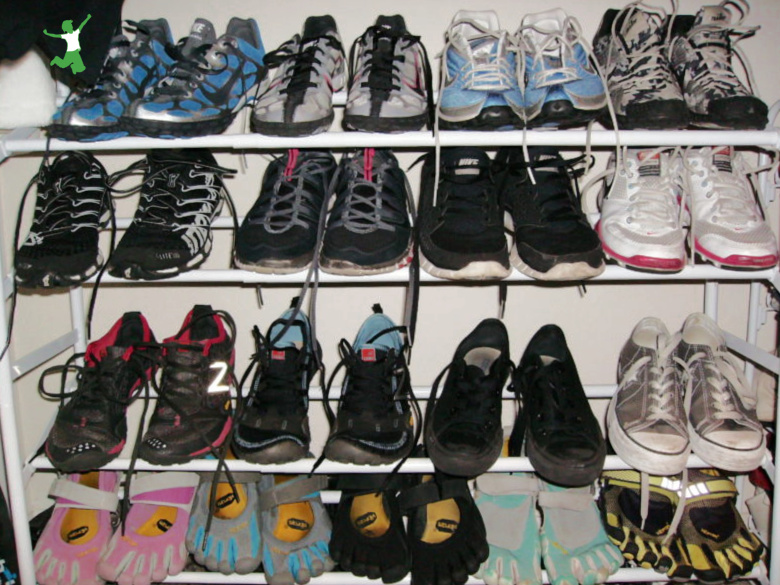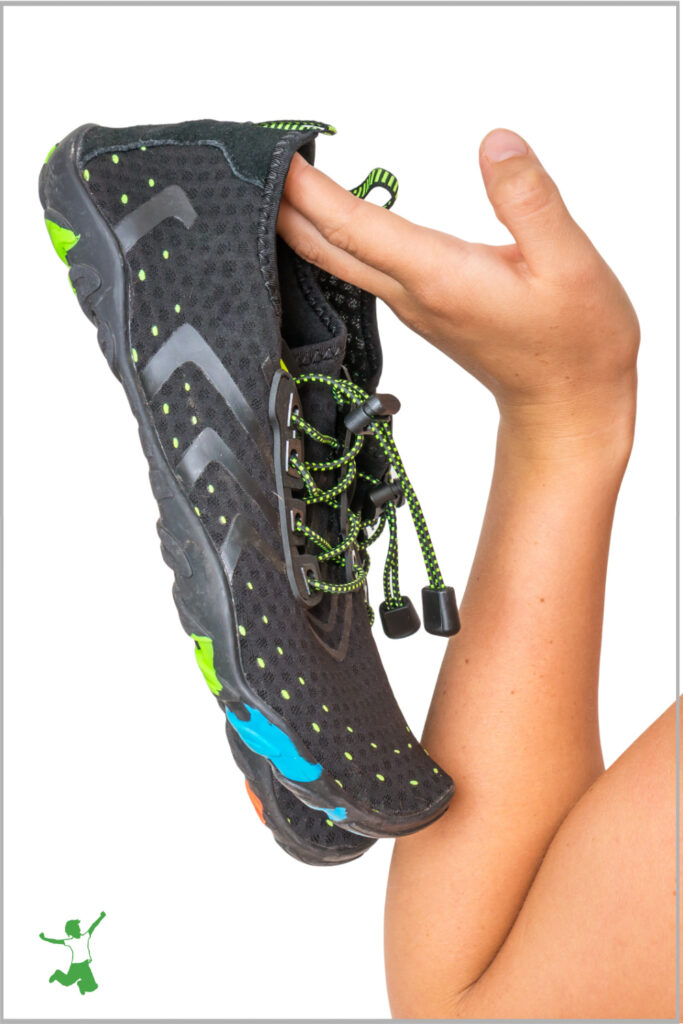Table of Contents[Hide][Show]
Why going barefoot as much as possible maintains foot health for optimal structural integrity and reduces inflammation in the tendons, bones, and joints.

Go against nature. That is what modern man seems to do best.
Plain and simple–take a look around and observe what happens when we do.
Fake egg whites dyed yellow in cartons, powdered milk and proteins along with refined vegetable oils will do much to ruin your health.
Add to that list man-made foot crutches; bound up artificial materials, elevated softened heel support, padded inserts, padded cushions, arch supports, insoles, and orthotics. Go ahead–spend some time in big clunky shoes and see what happens to your body over the long run–no pun intended.
We were born barefoot to continuously ground with Mother Earth and built to run.
The massive amount of free electrons from earthing via the soles of our feet is the most powerful anti-inflammatory known to science, in fact!
And man has been walking and running that way for eons until the recent onslaught of platform sneakers in the late seventies.
Now I don’t suggest that you show up for work Monday morning wearing nothing but your five bare toes, but walking, running and just wearing shoes with artificial support, in general, will wreak havoc on your feet, ankles, knees, hips, and lower back.
The cumulative damage will most likely cause grave orthopedic concerns.
But “what?”, you say “I have flat feet!” I don’t doubt it and I’ll bet they are also weak with atrophied muscles. A small percentage of the populace is actually born that way but for most of us, it is developed.
{Editor’s note: flat feet can also indicate poor and undeveloped bone structure caused by a lack of the fat-soluble vitamins A, D, and K2 while in the womb as researched by Dr. Weston A. Price early in the last century}.
Reasons to go barefoot. . .
There are several very important reasons to go barefoot as much as possible for your health. These include:
- The big fat cushiony heel support found in modern-day running shoes goes against our natural gait and can result in a shortened Achilles tendon and calf muscle.
- It takes more energy to run with the extra weight of the shoes.
- Worst of all, they are designed to make you land with your heel while we are designed (by nature) to land on our forefoot. The repetitive strain of slamming on your heel results in undue shock and potential joint injury. By landing on the ball or forefoot with light steps allows our arch to act as the natural spring that it is.
- By wearing all that fake support our muscles, tendons, and ligaments have weakened. And that’s not only the ones found in our feet bus also in our hips and legs. This will also decrease coordination, agility, and balance.
Start Slow!
So what should you do if you want to try opting into the barefoot trend?
First and foremost, go slow and avoid the goal of logging long distances every week. Contrary to popular belief, training for and running a marathon is not healthy.
When I was first introduced to this concept I immediately did a 360 and threw out all 16 pairs of my Nikes and other clunky shoes.
I bought a pair of Vibram Five Fingers and started running. I was almost 50 at the time, did not run much, had poor running form, was inefficient in my efforts, and had some orthopedic concerns.
I first ran 800 m in them, not very far. My entire lower legs and feet were so sore I could barely walk for 5 days.
I continued however and tried to gradually build up the running but kept encountering the debilitating discomfort in my lower legs and feet.
Quite simply, they had gone soft and weak and were not yet ready for that type of endurance. Yet I continued and tore my left calf, a grade 1 strain that took about 6 weeks to heal (once I finally laid off).
Maybe they were wrong and I needed the support? No, I did not believe that–it made too much sense. Everything I researched everything concluded we were indeed meant to run barefoot or with a shoe that simulated that offering minimal to no support.
After the calf healed I started wearing them on a daily basis, usually about 12+ hours a day–analogous to simply going barefoot. My feet and lower legs still got a workout but I could walk fine with no discomfort.
After about a month of doing that for I began running short distances 2x a week and alternating every third day with a minimalist shoe like a Nike Free for longer runs that offered less support than the clunkers but more than the Vibrams.
I continued that route and eventually weaned myself off them and recently ran the 11.5 mile Tough Mudder in my Vibrams. Excellent shoes for trail running.
What I have noticed from a personal level is improved running efficiency, improved coordination, balance, agility and an overall sense of being more grounded. I have had 2 surgeries on my right knee and running and certain activities often aggravated it, but not anymore.
The occasional discomfort I would feel in my knee has disappeared.
In retrospect, I would say that the cumulative damage from walking, running and playing sports in improper footwear probably greatly contributed to the damage I sustained in my knee.
Sadly, I see children playing and running in improper footwear taking away from their natural ability to squat, run and jump which will likely lead to problems later in life.
If you are an efficient runner, perhaps younger or with little to no orthopedic concerns you should do fine with them. Convert slowly, testing the waters and increase usage wisely. Most of my clients have converted to running “barefoot” with little to no problems.
Some of my favorites as seen in the picture include Vibram Five Fingers, Inov8 195 & 180, and New Balance Trail Minimus. More and more barefoot footwear is hitting the market daily.
Do your feet and body a favor and throw out your clunkers because even though the shoe “fits” doesn’t mean you should wear it.
Editor’s Note: To learn more about the benefits of going barefoot and contacting the energy of the Earth directly, be sure to check out the acclaimed book Earthing, by Martin Zucker.









I agree with everything written here, but also want to add to the “warning” to take it slow. I was fast on my way to becoming an avid CrossFitter and as you know in the early days of Crossfit everyone was wearing the barefoot shoes. I started up and thought, I need to wear the shoes everyone else is. I was going to Crossfit 3-4 days a week and Brazilian Jiu Jitsu 3 days a week. I started getting pain in my Achilles. I thought it was nothing and just to train through it. While playing basketball over lunch it happened… ruptured my Achilles. The couple that owned our CrossFit box had just gone to a conference with other Crossfit owners. One of the speakers was an Orthopedic Surgeon and a Crossfit box owner. She gave a talk on what they were seeing at their box as well as other Crossfits. LOTS of inflamed Achilles and an unusual amount of torn ones. What they concluded was there were a lot of people that have been wearing the big drop shoes for a long time and had shortened Achilles and the explosive type of exercise in Crossfit was causing issues. She went on to give exercises to prepare your Achilles to enable people to wear 0 drop shoes as well as how you can test yourself to see if your feet are ready for them.
I think we should all consider how our own individual body reacts. I am a stay at home -homeschooling mom and am on my feet, on a concrete floor, all day. I stayed barefoot all day unless I went somewhere. I started having horrible hip pains and sciatica. So I started wearing my old tennis shoes and it relieved a great deal of pain. Then I went ahead and purchased a pair of Brooks shoes and my hip and sciatica pain is almost nonexistent. Although, when the spring and summer are here I walk around outside barefoot. So I wouldn’t go throwing out all of your shoes just yet. Make sure you can go barefoot.
Hi Crystal, I am also a stay at home, homeschooling mom, although not on concrete. You are totally right that we need to consider our surfaces. Concrete all day is not natural. You can get close to barefoot with a shoe like Whittins, which can be found on Amazon. They have a zero drop, so they don’t shorten your Achilles, they do have some cushion, they’re super flexible, and they have a nice wide toe bed. By flexing and not squishing your toes, you mimic barefoot movement, but you can take some pressure off with the cushion. Check out Anya’s reviews, anyasreviews.com, for more styles of barefoot shoes that can help you improve your form without the pressure of your cement floors.
So to be clear, are you saying that all the chiropractors selling custom orthotics have it wrong? That instead of wearing them, we should be walking barefoot? I have been wearing orthotics for 5 years now (I walk 2 miles a day most mornings) and while I have no foot or knee pain, I don’t think my back is getting any stronger walking up hills. So I have been following this research for a while. If I buy these shoes, should I just move away from my inserts slowly over time or cold turkey it?
It is my opinion based on my research that strengthening the feet by going barefoot is the best way to go. The problem with inserts and shoes in general is that they aren’t grounding, which is a healing process while the muscles in the foot are being strengthened. They are simply a band-aid for the existing problem of weak, inflamed feet.
Perhaps wear the inserts when you are wearing shoes, but go barefoot as much as you can (while grounding is optimal) to obtain the benefits from both?
Walking on the beach barefoot is absolutely the best, as it really strengthens all the muscles in the foot working hard in the moving sand while you are fully grounding and earthing at the same time. No wonder people love to do it so much!